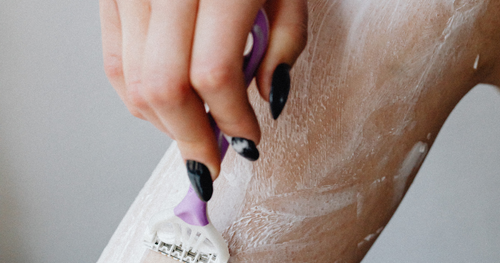When you think of strawberries, you have the image of the bright red fruit. However, this name is also attributed to a skin symptom known as strawberry legs. It does not evoke happy feelings, as the strawberry fruit would for some, but it is completely harmless. Strawberry legs causes vary widely but can be targeted with a few changes in your body skincare practices.
Strawberry skin legs create a contrast between your hair follicles and skin color. Its appearance is similar to that of the seeds of strawberries, hence the name. The stark contrast can be noticed even more after hair removal techniques, such as shaving and waxing.
Knowing the causes of strawberry legs can help effectively guide you when making treatment choices. Equally important is understanding how to maintain proper care when caring for strawberry legs. Keep reading to discover the 3 common strawberry legs causes.
1. Poor shaving techniques
Does shaving cause strawberry legs? -Yes, shaving can cause strawberry legs if done incorrectly. There is a proper way to shave to avoid infection, irritation, and inflammation. In addition, the maintenance of your shaving tool is also key in your body care routine.
You’re cutting off the hair at the surface when you shave, exposing the follicle. If you have thicker hair, the follicle may appear darker, giving the impression of strawberry legs. To be clear, shaving is not the cause of hair thickening. Hair growth occurs beneath the skin, and the hair’s width cannot be affected by changes made at the skin’s surface. However, shaving mistakes can cause strawberry legs.

Your pores can be left open depending on the water temperature you use while shaving. Warm or hot water can open your pores. If your shaving technique is poor, it can introduce bacteria. Therefore, avoid using dull and old razors, which can cause nicks and breed bacteria. In addition, you can experience folliculitis because of bacterial infection. Folliculitis can present as a post-inflammatory condition after shaving and can look like strawberry legs but mostly manifest as acne-like clusters.
To prevent strawberry skin on legs after shaving, change your razors often, store razors in moisture-free environments, avoid dry shaving, and use a shaving cream/gel/oil.
2. Clogged pores
You’ve most likely heard of clogged pores leading to acne. It is a common skin concern that some experience on the face, but it can also happen in other areas of the body with pores. Strawberry skin on thighs or legs can be a result of clogged pores.
Trapped bacteria, dead skin cells, oil, and debris can accumulate and clog your pores. The mixture of these elements can appear dark on your legs, giving the impression of strawberry legs. In addition, clogged pores can look more prominent in appearance, making strawberry legs more noticeable.
Clogged pores can result from the overproduction of oil by the skin. It can also be due to a lack of exfoliation, which causes dead skin cell retention. Genetic conditions, such as keratosis pilaris, can also lead to clogged pores due to the buildup of keratin.
Clearing your skin of excess buildup is essential when dealing with clogged pores. Strawberry legs products, such as chemical exfoliators, can help unclog pores. For instance, salicylic acid is a beta-hydroxy acid that breaks down dead skin cells and oils that clog the pores.
3. Parched/Dehydrated skin
Another one of the causes for strawberry legs is skin dehydration. Water is essential to skin health and is needed for various skin functions. Dehydrated skin is a skin condition that can be described as a transition the skin goes through when experiencing low water content. This transition can be noticed with various skin types, such as dry, oily, and combination skin.
There are different causes of skin dehydration, some of which are the use of harsh products, lack of internal hydration, and excessive exfoliation. Skin can become less elastic once dehydrated, in which case you may experience uncomfortable skin tightness and itching.

Dehydration is marked by decreased water content, which compromises the skin barrier. Without the appropriate amount of water, skin function is challenged. In addition, dehydration makes it difficult for the skin to retain moisture, further exacerbating the symptoms. The irritation and inflammation likely to result due to dehydrated skin can contribute to the appearance of strawberry legs.
Lifestyle changes, in addition to healthier skincare choices, can be used to relieve dehydrated skin. To restore healthy skin function, internally hydrate and choose the proper strawberry legs products. It is important to address your body care routine to ensure each step caters to your skin’s hydration. In addition, ingredients such as glycerin and hyaluronic acid are important to incorporate into your moisture routine.





Leave a Reply